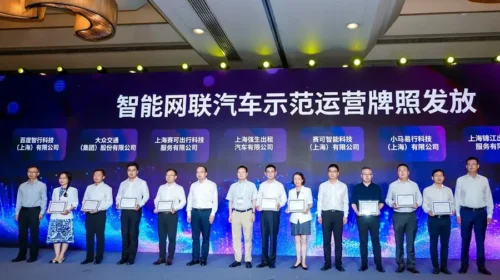EnjoyGo shifts gears to driverless future on road to IPO

The mobility arm of auto giant SAIC is making a Hong Kong listing to raise funds for development of self-driving car services, among other purposes
Key Takeaways:
- EasyGo, the mobility arm of state-owned auto giant SAIC Motor, has filed for a Hong Kong IPO
- The company is one of a growing number in China trying to commercialize robotaxi services
By Warren Yang
Investors already have a wide array of robotaxi operators from China to choose from these days, led by the leading trio of Pony AI, WeRide and Baidu, followed by lesser names like Momenta and Chenqi. Now, these private companies are about to get a run for their money from a state-run rival, as EnjoyGo Technology Ltd. gets set to join their ranks, banking on self-driving cars to take it to profits.
Last Tuesday, the mobility arm of state-owned auto giant SAIC Motor, the China joint venture partner to GM and Volkswagen, filed for an IPO in Hong Kong. One reason it gave for the move was to raise R&D funds for its autonomous driving, or robotaxi, services.
Ride-hailing services currently account for the bulk of EnjoyGo’s revenue. But that field is even more crowded than the emerging robotaxi business, dominated by DiDi Global, followed by competition from many other smaller challengers — to the point where a number of regional governments have warned that the competition is dangerously overheated. EnjoyGo has a tiny market share in that regard and is also unprofitable, despite its homefield advantage in Shanghai, China’s commercial capital where SAIC is one of the largest state-owned companies.
So, the company clearly needs a new — and profitable — revenue source, and it appears to think self-driving taxis fit that bill. That seems reasonable, to some extent. For starters, Beijing seems determined to make China a global leader in autonomous driving technologies, as reflected by the crowded state of the field. And EnjoyGo is relatively advanced in this quickly emerging field, which can give the company an edge in the race.
Its SAIC ties look like one of EnjoyGo’s most important assets, as the parent company can provide it with self-driving vehicles tailored to its needs. And the carmaker’s government ownership presumably means it’s likely to shower EnjoyGo with many forms of support in its bid to help the national and local governments meet their policy objectives.
In its Hong Kong IPO document, citing third-party research, EnjoyGo says it was China’s first platform to be backed by a carmaker and can operate robotaxis operating at Level 4 (L4) driving — a category for cars that can drive themselves without human assistance under many conditions. The company aims to start its commercial robotaxi services in Shanghai’s Pudong New District by the end of this year and expand them to other cities by 2027.
Yet any revenue from robotaxi services is likely to be minimal for the foreseeable future. Among other things, it’s not clear how quickly people will start feeling comfortable riding cars without human drivers. That could take some time, and any major accident can spark safety concerns and lead to a big setback that quickly erases progress toward full acceptance. What’s more, the service is also limited in area, and many operators initially provide heavy subsidies to attract riders, pushing profitability further down the road.
So, EnjoyGo has little choice but to rely on its money-losing ride-hailing app for now, at least to show investors it’s capable of generating some revenue. The company ranked fifth in terms of gross transaction value (GTV) in that space last year, with a tiny single-digit market share. Even though its ride-hailing services cover more than 80 cities in China, with over 1 million registered drivers, it seems to generate much of its business in its home market of Shanghai, where it is the largest player behind DiDi.
Improving margins
Encouragingly, the company’s losses are narrowing, even as its revenue has slipped into reverse. Its total revenue fell about 3% year-on-year to 3 billion yuan ($421 million) in the first half of this year. But its gross margin improved substantially as it trimmed costs for drivers, rising to 11% in the first half of this year from 6.6% a year earlier.
While the improving margin is commendable, it’s still quite low for an online service company. To put it in perspective, it’s on par with the gross profit margin of SAIC, which has a much heavier cost structure as a manufacturer. And WeRide’s (WRD.US) gross margin of 28.5% for the 12 months to June, and Pony AI’s (PONY.US) 17.0%, show EnjoyGo still has plenty of catching up to do. Regardless, the margin improvement helped EnjoyGo narrow its net loss for the first half of this year by 46% year-on-year to 115 million yuan.
Even if EnjoyGo’s ride-hailing business does become profitable, it isn’t likely to become a big money maker very quickly, given how intense the competition is. The company also offers services for vehicle leasing and used car sales. But revenue from them is small, accounting for a little more than 20% of its total sales, and it doesn’t look like either business will be a game changer for EnjoyGo.
All this makes the robotaxi business look like one of the most promising potential drivers for EnjoyGo’s future growth. Goldman Sachs projects that self-driving taxis will be on roads in more than 10 cities in China by 2030 and collectively form a $47 billion market in the country by 2035. The investment bank forecasts that each robotaxi will generate $69 a day in net proceeds for operators by 2035, higher than $28 to $56 that a ride-hailing vehicle earns on average, because self-driving cars can operate longer hours.
This all sounds promising, if not for all the competitors, some with big head starts and also rich financial resources. Baidu’s legacy online search business generates huge money it can use to support its Apollo Go robotaxi service, and both WeRide and Pony AI are currently planning to raise big sums with new Hong Kong IPOs after making U.S. listings a year ago. So EnjoyGo will hardly have easy going with its robotaxi ambitions, even though it could have some advantages in Shanghai.
There’s no denying that autonomous driving is likely to be the next big thing in the auto industry, both for personal driving and taxis. That may partly explain the inflated valuations for Pony AI and WeRide, which trade at price-to-sales (P/S) ratios of 100 and 55, respectively. Neither company is profitable, but such lofty valuations show investors have high hopes for both on the potential for self-driving taxis.
EnjoyGo is hoping to capitalize on similar optimism. But its relatively late arrival to the race could dampen enthusiasm, despite the company’s strong backing from SAIC and its enviable home field advantage in Shanghai.
To subscribe to Bamboo Works weekly free newsletter, click here






